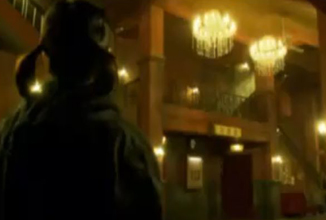So-dan (Kim Kkobbi) is a disillusioned schoolgirl who has neither a lust for life nor any real hope for the future. Late one night, her grandmother (with whom she lives alone) announces that she is going to the local cinema to see an old film which she starred in years earlier, but when she fails to return, So-dan (both worried about her and with little else to do) decides to go to the cinema herself to find her.
On arriving, she discovers that the movie theatre is rundown and close to ruin, and is inhabited by an equally dilapidated group of weird and eccentric individuals who, strangely, seem to recognise her, but when she brings up the subject of her grandmother and the film, they become noticeably agitated, insisting that the film is cursed and refusing to discuss it further.
Determined not to be put off, and in order to continue her search for her granny, So-dan starts to work in the cinema box office, but as darkness falls the ghosts come out to play...
If you were to take the gothic comedy horror of Bettlejuice, change the overall hue from blue to eerie green, add a smattering of The Rocky Horror Picture Show and sprinkle a smidgen of the story of Theseus and The Minotaur on top, you'd come pretty close to creating a recipe for Ghost Theatre.
The film (also known as Midnight Ballad For Ghost Theatre) begins at a gentle pace, resolutely refusing to be rushed and, as is the case with so many Korean horror films, the first supernatural "incident" doesn't actually occur for some time.
However, that in itself allows for the eccentricities and idiosyncrasies of all of the main characters to be referenced within their ‘daily’ lives, well before they have to perform any of their night time song and dance routines.
Not only that, but this pacing also gives ample space to both pay deliberate homage to many classic horror tale elements (creaking doors, rolling mist, seemingly disembodied voices, etc.), and also build an ever growing (and humorous) eeriness within proceedings, all in an utterly tongue-in-cheek manner.
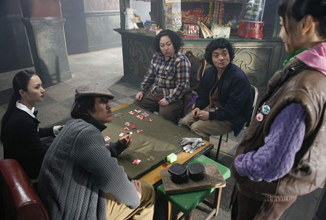 |
 |
By the time So-dan has her first ‘real’ ghostly encounter, we have been repeatedly (gently) nudged to expect it on several occasions, to the extent that its humorous arrival comes laced with an element of relief and is all the funnier as a result.
It does have to be said that not all of the humour in Ghost Theatre is one hundred per cent successful but it is executed with such genuine warmth throughout, by both the cast and filmmakers, that even the sections which don’t actually make you physically laugh will raise a smile, nonetheless.
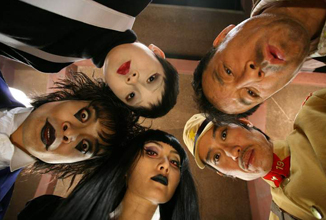 |
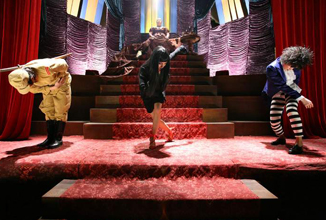 |
Director Jeon Gye-soo’s background is in theatre and it shows cinematically in almost every scene of Ghost Theatre. With only a few sets used throughout, a relatively small cast and fairly static camera angles, the film actually feels like a musical stage play performed specifically for each viewer in the ‘audience’.
In fact, the only thing that prevents Ghost Theatre from being ripe for becoming a cinema sing-along cult, much as Rocky Horror has, is that there aren’t really enough songs in the film to warrant it, and though the relatively small number of musical pieces doesn’t actually detract from the plotline or the overall effect, a few more would certainly have been a worthwhile addition. “Leave them wanting more”, so they say, but they also say “You can never have too much of a good thing”.
As far as the songs themselves are concerned, the bridges and choruses are largely stronger than the verses with much more noticeable and memorable musical hooks, and it is those hooks combined with beautifully exuberant performances from the cast that ultimately make them a success.
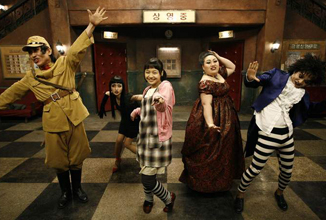 |
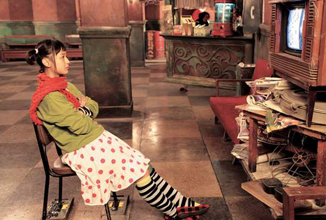 |
No discussion of Ghost Theatre would be complete, however, without mention of the film's monster - a creature linked to the aforementioned cursed film, which instills utter fear in the majority of the characters.
Reminiscent of the type of monsters created for a plethora of B movies of the fifties and sixties, it instantly brings to mind a number of films from that period - both classic monster movies and also those based on one story from Greek mythology or another. Whether that similarity was a deliberate choice on the part of Jeon Gye-soo, or simply an inadvertent coincidence brought on by, perhaps, financial constraints, is open for debate but considering what type of creature the monster is supposed to be, its design brings a feeling of nostalgia; a tickle to the funny bone; and, to my mind, serves its comedy horror purpose almost perfectly, despite its simplicity.
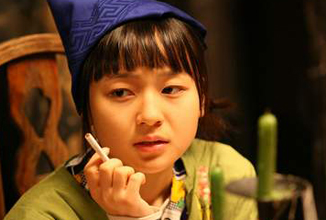 |
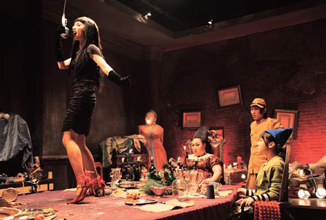 |
Cast:
Ghost Theatre is Kim Kkobbi's film from start to finish, plain and simple. It was her first starring role and serves as a showcase for not only her acting talent, but also her singing, dancing and comedy timing. In short, Ghost Theatre would be much less of note without her.
That's not to say that the other cast members don't play their part in the overall scheme of things - they do, and each provides an accomplished performance throughout - it's just that Kim Kkobbi hits the musical numbers in which she takes part like a force of nature, and hers will be the performance you remember far more than any other.
The utter glee So-dan shows while peforming a musical routine may simply be what Kim Kkobbi was asked to provide for the role, but it seems so utterly real, one can't help but wonder if viewers are actually seeing a glimpse of the real-life pleasure she was feeling in being the star of a film such as this - especially one with so much in common with The Rocky Horror Picture Show and Bettlejuice, as it's fairly well known that she is a huge fan of both films.
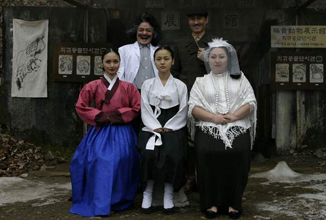 |
 |
Summary:
Regardless of your particular preference within Korean Cinema, there are times when we all just want to be warmly entertained, and if that's what your hankering for, Ghost Theatre really is something to make a song and dance about.
Cast
Kim Kkobbi, Cheon Ho-jin, Park Joon-myeon, Jo Hee-bong, Han Ae-ri
DVD
The DVD edition reviewed here is the Korean (Region 3) CJ Entertainment Single Disc edition. The film itself is provided as an anamorphic transfer with an aspect ratio of 2.35:1 and there are no image artifacts (and no ghosting) present. The picture is absolutely exemplary and compliments the beautifully colourful and eerie visuals perfectly.
The original Korean language soundtrack is provided as a choice of Dolby Digital 5.1 and Dolby Digital 2.0, both of which are crisp and clear. The musical score is also well balanced and noticeably nuanced throughout.
Excellent subtitles are provided throughout the main feature but English-speaking viewers should note that, as with many Korean DVD releases, there are no subtitles available on any of the extras.
DVD Details:
• Director: Jeon Gye-soo
• Format: NTSC, Anamorphic, Widescreen, Subtitled
• Language: Korean
• Subtitles: English/Korean
• Sound: Dolby Digital 5.1, Dolby Digital 2.0
• Region: Region 3
• Aspect Ratio: 2.35:1
• Number of discs: 2
• Classification: 12 (Korean Film Classification)
• Studio: CJ Entertainment
• Run Time: 120 minutes (approx.)
DVD Extras:
· Making Of
· Deleted Scenes
· Musical Sequences Making Of
· Musical Drama
· Music Video
· Theatrical Trailer
|



